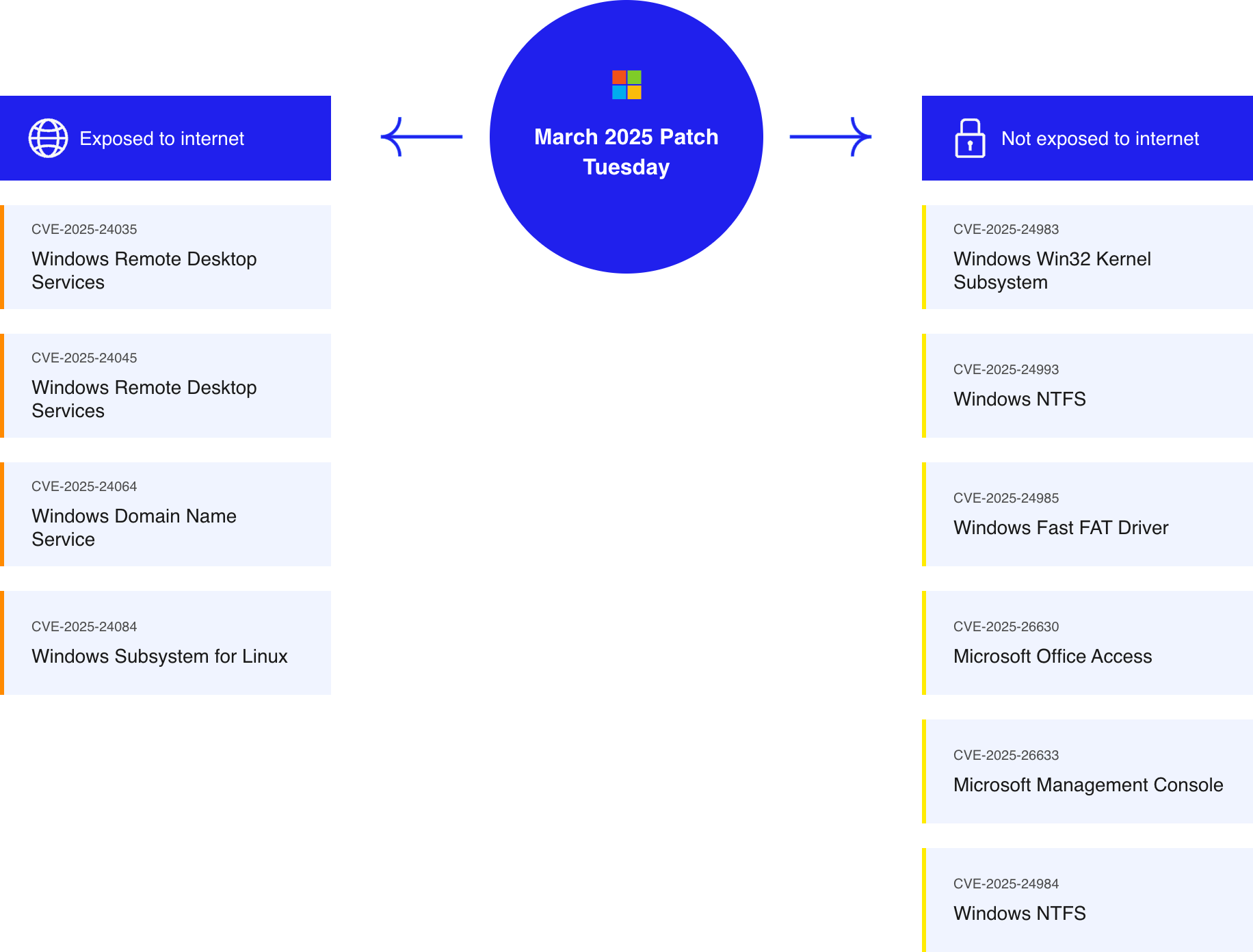Article
March 2025 Patch Tuesday: Key Vulnerabilities Overview
Introduction
Microsoft’s third security update includes patches for over 50 vulnerabilities across various Windows systems, including fixes for six zero-day vulnerabilities currently being exploited. This article explains their impact and the steps needed to secure your systems.
Summary of March 2025 Patch Tuesday
March 2025’s Patch Tuesday introduces several key security improvements, addressing vulnerabilities across various Microsoft products. This update resolves numerous CVEs (Common Vulnerabilities and Exposures), some of which are considered critical due to their potential exposure to attackers over the internet. By applying these patches, users can safeguard their systems against unauthorized access and ensure personal and organizational data remains secure.
Understanding these updates is crucial in protecting enterprise environments. Below, we categorize the vulnerabilities based on their exposure to the internet.
Updates are listed according to their CVSS Score

Exposed to the Internet
Windows Remote Desktop Services – Remote Code Execution
This vulnerability arises from the improper storage of sensitive data in unlocked Windows Remote Desktop Services, allowing unauthorized attackers to execute arbitrary code over a network.
Windows Remote Desktop Services – Use-After-Free
Remote Desktop Services are affected by a use-after-free vulnerability that can potentially lead to remote code execution, compromising the security of remote user sessions.
Windows Domain Name Service – Remote Code Execution
A vulnerability in Windows Domain Name Service (DNS) server arises from parsing specially crafted DNS responses, allowing remote code execution which could disrupt typical name resolution operations critical for network functionality.
Windows Subsystem for Linux – Untrusted Pointer Dereference
The Windows Subsystem for Linux (WSL) has an untrusted pointer dereference vulnerability that may lead to remote code execution, risking kernel stability and data security.
Internal Network
Windows Win32 Kernel Subsystem – Elevation of Privilege
The Win32 Kernel Subsystem, a core component of the Windows OS, has a vulnerability that allows elevation of privilege, potentially providing unauthorized SYSTEM access.
Windows NTFS – Buffer Overflow
NTFS, used for efficient data storage on Windows systems, has a buffer overflow vulnerability that could lead to remote code execution when a malicious VHD is mounted.
Windows Fast FAT Driver – Remote Code Execution
The Fast FAT Driver in Windows, which reads FAT (File Allocation Table File Allocation Table) files systems from external storage devices, is susceptible to remote code execution when a malicious VHD (Virtual Hard Disk)triggers the vulnerability.
Microsoft Office Access – Remote Code Execution
Microsoft Access, a database management system, is vulnerable to remote code execution through specially crafted documents, posing a risk to data integrity and security.
Microsoft Management Console – Security Feature Bypass
The Microsoft Management Console, a framework for administrative tools, is affected by a Security Feature Bypass vulnerability that could allow potential code execution.
Windows NTFS – Information Disclosure
This vulnerability in NTFS leads to information disclosure due to improper handling of a malicious USB device, potentially affecting data privacy in enterprise environments.
Conclusion
Understanding the distinction between internet-exposed and internal vulnerabilities helps prioritize updates and maintain a robust security posture. As cybersecurity threats evolve, staying informed and applying timely updates can make a significant difference in protecting your digital environment from potential exploits.
Have questions about implementing these patches or securing your IT environment? Schedule a call with At-Bay’s Advisory Services team to get started.
About CVSS
The Common Vulnerability Scoring System (CVSS) is an industry-standard framework for evaluating and communicating the severity of software vulnerabilities. It provides a numerical score that helps organizations prioritize and address security issues effectively. CVSS scores quantify the severity of a vulnerability on a scale from 0 (no severity) to 10 (critical severity). CVSS considers multiple factors, including; Exploitability, Impact, Exploit code maturity, Remediation level, Report confidence. The system enables organizations to compare and prioritize vulnerabilities based on their potential impact on IT infrastructure.
Read More
- https://msrc.microsoft.com/update-guide/releaseNote/2025-mar
- https://community.spiceworks.com/t/patch-tuesday-alert-march-2025/1184429
- http://www.rapid7.com/blog/post/2025/03/11/patch-tuesday-march-2025/
- https://www.tripwire.com/state-of-security/march-2025-patch-tuesday-analysis
- https://www.thezdi.com/blog/2025/3/11/the-march-2025-security-update-review
- http://www.crowdstrike.com/en-us/blog/patch-tuesday-analysis-march-2025.html
- https://www.helpnetsecurity.com/2025/03/10/march-2025-patch-tuesday-forecast/
- https://blog.talosintelligence.com/march-patch-tuesday-release/